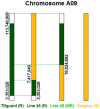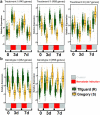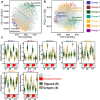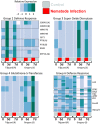Gene expression profiling describes the genetic regulation of Meloidogyne arenaria resistance in Arachis hypogaea and reveals a candidate gene for resistance
- PMID: 28465503
- PMCID: PMC5430994
- DOI: 10.1038/s41598-017-00971-6
Gene expression profiling describes the genetic regulation of Meloidogyne arenaria resistance in Arachis hypogaea and reveals a candidate gene for resistance
Abstract
Resistance to root-knot nematode was introgressed into cultivated peanut Arachis hypogaea from a wild peanut relative, A. cardenasii and previously mapped to chromosome A09. The highly resistant recombinant inbred RIL 46 and moderately resistant RIL 48 were selected from a population with cv. Gregory (susceptible) and Tifguard (resistant) as female and male parents, respectively. RNA-seq analysis was performed on these four genotypes using root tissue harvested from root-knot nematode infected plants at 0, 3, 7 days after inoculation. Differential gene expression analysis provides evidence that root-knot nematodes modulate biological pathways involved in plant hormone, defense, cell signaling, cytoskeleton and cell wall metabolism in a susceptible reaction. Corresponding to resistance reaction, an effector-induced-immune response mediated by an R-gene was identified in Tifguard. Mapping of the introgressed region indicated that 92% of linkage group A09 was of A. cardenasii origin in Tifguard. RIL46 and RIL 48 possessed 3.6% and 83.5% of the introgression on A09, respectively. Within the small introgressed region carried by RIL 46, a constitutively expressed TIR-NBS-LRR gene was identified as the candidate for nematode resistance. Potential defense responsive pathways include effector endocytosis through clathrin-coated vesicle trafficking, defense signaling through membrane lipid metabolism and mucilage production.
Conflict of interest statement
The authors declare that they have no competing interests.
Figures





Similar articles
-
Comparative root transcriptome of wild Arachis reveals NBS-LRR genes related to nematode resistance.BMC Plant Biol. 2018 Aug 6;18(1):159. doi: 10.1186/s12870-018-1373-7. BMC Plant Biol. 2018. PMID: 30081841 Free PMC article.
-
Genetic Mapping of Resistance to Meloidogyne arenaria in Arachis stenosperma: A New Source of Nematode Resistance for Peanut.G3 (Bethesda). 2015 Dec 12;6(2):377-90. doi: 10.1534/g3.115.023044. G3 (Bethesda). 2015. PMID: 26656152 Free PMC article.
-
Identification of RAPD, SCAR, and RFLP markers tightly linked to nematode resistance genes introgressed from Arachis cardenasii into Arachis hypogaea.Genome. 1996 Oct;39(5):836-45. doi: 10.1139/g96-106. Genome. 1996. PMID: 8890516
-
A new source of root-knot nematode resistance from Arachis stenosperma incorporated into allotetraploid peanut (Arachis hypogaea).Sci Rep. 2019 Nov 27;9(1):17702. doi: 10.1038/s41598-019-54183-1. Sci Rep. 2019. PMID: 31776412 Free PMC article.
-
Root Transcriptome Analysis of Wild Peanut Reveals Candidate Genes for Nematode Resistance.PLoS One. 2015 Oct 21;10(10):e0140937. doi: 10.1371/journal.pone.0140937. eCollection 2015. PLoS One. 2015. PMID: 26488731 Free PMC article.
Cited by
-
Fluopyram or Resistant Cultivars Manage Meloidogyne arenaria Infestation in Virginia-Type Peanut Production.J Nematol. 2025 Apr 22;57(1):20250010. doi: 10.2478/jofnem-2025-0010. eCollection 2025 Feb. J Nematol. 2025. PMID: 40264846 Free PMC article. Review.
-
Tomato locule number and fruit size controlled by natural alleles of lc and fas.Plant Direct. 2019 Jul 3;3(7):e00142. doi: 10.1002/pld3.142. eCollection 2019 Jul. Plant Direct. 2019. PMID: 31312784 Free PMC article.
-
Mitigating Aflatoxin Contamination in Groundnut through A Combination of Genetic Resistance and Post-Harvest Management Practices.Toxins (Basel). 2019 Jun 3;11(6):315. doi: 10.3390/toxins11060315. Toxins (Basel). 2019. PMID: 31163657 Free PMC article. Review.
-
Relics of interspecific hybridization retained in the genome of a drought-adapted peanut cultivar.G3 (Bethesda). 2024 Nov 6;14(11):jkae208. doi: 10.1093/g3journal/jkae208. G3 (Bethesda). 2024. PMID: 39217411 Free PMC article.
-
Initiation of genomics-assisted breeding in Virginia-type peanuts through the generation of a de novo reference genome and informative markers.Front Plant Sci. 2023 Jan 27;13:1073542. doi: 10.3389/fpls.2022.1073542. eCollection 2022. Front Plant Sci. 2023. PMID: 36777543 Free PMC article.
References
-
- Minton, N. A. & Baujard, P. Nematode parasites of peanut. Plant parasitic nematodes in subtropical and tropical agriculture. M. Luc, R. A. Sikora and J. Bridge. Wallingford, UK, CABl, 285–320 (1990).
Publication types
MeSH terms
LinkOut - more resources
Full Text Sources
Other Literature Sources
Research Materials
Miscellaneous

